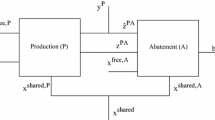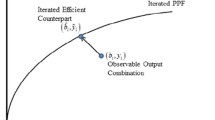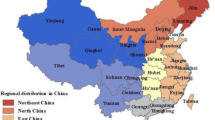Abstract
The Integrated Pollution and Prevention Control (IPPC) directive from the European Union implies that regulatory emission caps shall be set in accordance with each industry’s Best Available Techniques (BAT). The directive, which represents a harmonization of environmental regulations towards a BAT principle, is currently being implemented in all the EU member states and the states associated with the European Economic Area. The aim of this paper is to examine the effect of this implementation on emission reductions and costs, using data from Norwegian manufacturing industries. Data Envelopment Analysis (DEA) is used to construct a frontier of all efficient installations. The frontier is based on all installations within an industry that use the Best Practice Technique (BPT). We estimate the changes in emissions due to the implementation of IPPC as the difference between an installation’s actual emissions and the emissions that would occur if it operated on the frontier. The method reveals a strong potential for emission reductions. Further, estimates of short-run abatement costs indicate that considerable emission reductions can be achieved with low or no costs, but that the implementation of a strict BAT principle for all installations involves substantial costs. To the extent that the abatement costs of an installation would be excessive, IPPC includes some limited modifications of the strict BAT principle. It seems important that these modifications are fully utilized by authorities to achieve the most cost efficient implementation of the directive.
Similar content being viewed by others
References
Alberini A, Segerson K (2002) Assessing voluntary programs to improve environmental quality. Environ Resour Econ 22: 157–184
Asdal K (1998) Knappe ressurser? Økonomenes grep om miljøfeltet (Exhaustible resources? The economy’s hold on the environment). Universitetsforlaget, Oslo
Banker RD, Charnes A, Cooper W (1984) Some models for estimating technical change and scale inefficiency in data envelopment analysis. Manage Sci 30(9): 1078–1092
Berkhout F, Hertin J, Carlens J, Tyteca D, Olsthoorn X, Wagner M, Wehrmeyer W (2001) ‘Green-ness’ can be measured. Eur Bus Forum 6: 42–47
Bruvoll A, Bye TA, Larsson J, Telle K (2003) Technological change in the pulp and paper industry and the role if uniform versus environmental policy. Discussion Paper No. 357, Statistics Norway, Oslo
Bugge HC (1999) Forurensningsansvaret (The pollution liability). Tano Aschehoug, Oslo
Cooper WW, Seiford LM, Tone K (2006) Introduction to data envelopment analysis and its uses: with DEA solver software and references. Springer, New York
Farrell MJ (1957) The measurement of productive efficiency. J R Stat Soc Ser A 120(III): 253–281
Fatta D, Marneri M, Papadopoulos A, Moustakas K, Haralambous KJ, Loizidou M (2003) Development of guidelines on best practices for the slaughter of animals in Cyprus. Waste Manag 23: 157–165
Faure M, Lefevere JGJ (1999) Integrated pollution prevention and control: an economic appraisal. In: Backers C, Betlem G(eds) Integrated pollution prevention and control. Kluwer Law International, London, pp 93–120
Färe R, Grosskopf S (2000) Reference guide to OnFront. EMQ AB, Lund
Färe R, Primont D (1995) Multi-output production and duality: theory and applications. Kluwer Academic publisher, Norwell, MA
Førsund FR (1992) BAT and BATNEEC: an analytic interpretation. Memorandum from the Department of Economics No. 28. University of Oslo, Oslo
Førsund RF, Hjalmarsson L (1987) Analyses of industrial structure: a putty-clay approach. Almquist & Wiksell, Stockholm
Gelderman J, Rentz O (2001) Integrated technique assessment with imprecise information as a support for the identification of best available techniques (BAT). ORSpektrum 23: 137–157
IPPC (1996) European integrated pollution prevention control directive, 96/61/EC. The Council of the European Communities, Brussels
Jaffe BA, Newell RG, Stavin RN (2002) Environmental policy and technological change. Environ Resour Econ 22: 44–69
Johansen L (1972) Production functions. North-Holland, Amsterdam
Lansink A, Silva E (2003) CO2 and energy efficiency of different heating technologies in the Dutch glasshouse industry. Environ Resour Econ 24: 395–407
Larsson J, Telle K (2003) Dokumentasjon av DEED—en database over bedriftspesifikke miljødata og økonomisk data for forurensende norske indsustribedrifter (Documentation of DEED—a database of plant specific environmental and economic data for Norwegian polluting plants). Notater 2003/91, Statistics Norway, Oslo
Lübbe-Wolff G (2001) Efficient environmental legislation—on different philosophies of pollution control in Europe. J Environ Law 13: 97–87
Lyon Thomas P, Maxwell John W (2001) Voluntary approaches to environmental protection. In: Franzini M, Nicita A(eds) Economic institutions and environmental policy. Ashgate Publishing, Aldershot
Ministry of Environment (2002) Foreskrift om behandling av tillatelser etter forurensingsloven (Regulation on treatment of permits) FOR 2002–04-16 nr 362 (now incorporated in FOR-2004-06-01-931 without material changes). Miljøverndepartementet, Oslo
Ot. prp. (Odelstingsproposisjon) 11 (1979–1980), Om lov om vern mot forurensninger og om avfall (Forurensningsloven) (White Paper to the anti-pollution law)
Ot. prp. (Odelstingsproposisjon) 59 (1998–1999), Om lov om endring i forurensningsloven av 13. March 1981 nr. 6 (White Paper on changes to the anti-pollution law of 1981)
Pasurka CA (2001) Technical change and measuring pollution abatement costs: an activity analysis framework. Environ Resour Econ 18: 61–85
Pearce D, Brisson I (1993) BATNEEC: the economics of technology-based environmental standards, with a UK case illustration. Oxford Rev Econ Policy 9(4): 24–40
Pellini T, Morris J (2001) A framework for assessing the impact of the IPPC directive on the performance of the pig industry. J Environ Manage 63: 325–333
Pellini T, Morris J (2002) IPPC and intensive pig production in England and Wales: compliance costs, emission abatement and affordability. Eur Environ 12: 332–347
Phelps ES (1963) Substitution, fixed proportions, growth and distribution. Int Econ Rev 4: 265–288
Reinhard S, Lovell CAK, Thijssen GJ (2000) Environmental efficiency with multiple environmentally detrimental variables; estimated with SFA and DEA. Eur J Oper Res 121: 287–303
Schultmann F, Jochum R, Rentz O (2001) A methodological approach for the assessment of best available techniques—demonstrated for a case study from the steel industry. Int J Life Cycle Assess 6(1): 19–27
Shephard RW (1953) Cost and production functions. Princeton University Press, Princeton
Shephard RW (1970) Theory of cost and production functions. Princeton University Press, Princeton
Sorrell S (2002) The meaning of BATNEEC: Interpreting excessive costs in UK industrial pollution regulation. J Environ Policy Plann 4: 23–40
Statistics Norway (2003) Database of survey data on manufacturing plants. Statistics Norway, Oslo
Winter G (1999) The IPPC directive: a German point of view. In: Backes C, Betlem G(eds) Integrated pollution prevention and control. Kluwer Law International, London, pp 65–80
Zaim O (2004) Measuring environmental performance of state manufacturing through changes in pollution intensities: a DEA framework. Ecol Econ 48: 27–47
Author information
Authors and Affiliations
Corresponding author
Rights and permissions
About this article
Cite this article
Larsson, J., Telle, K. Consequences of the IPPC’s BAT Requirements for Emissions and Abatement Costs: A DEA Analysis on Norwegian Data. Environ Resource Econ 41, 563–578 (2008). https://doi.org/10.1007/s10640-008-9212-1
Received:
Accepted:
Published:
Issue Date:
DOI: https://doi.org/10.1007/s10640-008-9212-1




